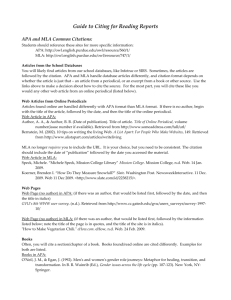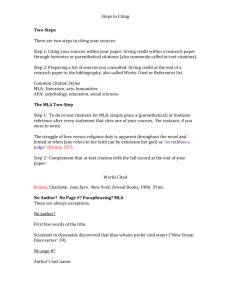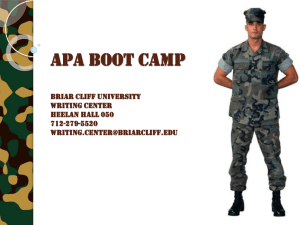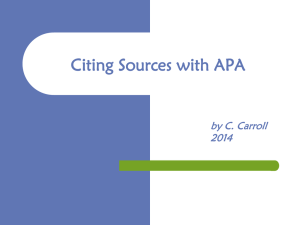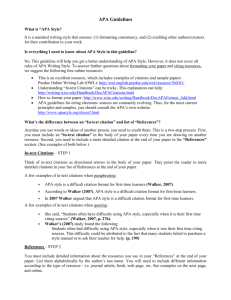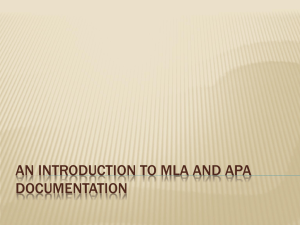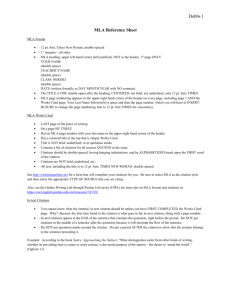MLA & APA Style Boot Camp - The University of West Georgia
advertisement
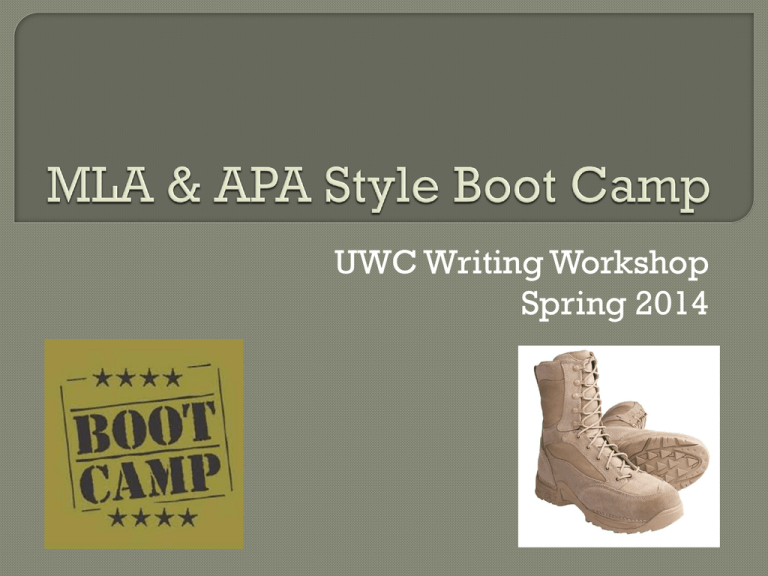
UWC Writing Workshop Spring 2014 MLA Style Who uses MLA?/Where did MLA style come from? • • • • • English Studies: Language and Literature Foreign Language and Literature Literary Criticism Comparative Literature Cultural Studies The most noticeable feature of MLA style is in-text parenthetical citations. This means NO footnotes. The Modern Language Association decided to introduce a system it liked better. MLA considers parenthetical citations easier on the eyes and the brain. Make sure to have 1 inch margins and double space throughout the entire document. Include your last name and page number in the upper right-hand corner of each page of the paper! (go to “Insert” tab, click on “Page Number,” select “Top of Page” and “Plain Number 3.” Then, go into header provided and type in your last name). Beginning on your first line, type in: • • • • Your Name Your Professor’s Name Class (i.e. ENGL 1101-01) Date (i.e. 2 November 2013) Include a title for the paper. DO NOT solely use the name of the story/novel/play/poem you are studying. When you begin any new paragraph, make sure to indent ½ inch (i.e. hit the “Tab” key once). When including a block quote in your work, make sure to indent 1 inch (i.e. hit the “Tab” key twice) and omit quotations marks from the quote. In-text citations can often be the hardest aspect to handle in MLA style. For each type of source, there is a slightly different way to complete the citation. The next few slides will show you a few of the most common in-text citations: • Author’s Name in a Sentence: As Paul Perilli points out, poets currently “are being seen, heard, and read by more and more people” (43). • Author’s Name in Parenthetical Citation: As one author points out, poets currently “are being seen, heard, and read by more and more people” (Perilli 43). • Poems: (Use line numbers and write “line” in the first citation). In “Song of Myself,” Walt Whitman uses the image, “With music strong I come, with my cornets and my drums” (line 361). • Electronic Source: (If no author is named, use the title. Many electronic sources lack page, paragraph, or section numbers). Peter Davis gave [Armstrong] “basic musical training on the cornet” (“Louis Armstrong”). A works cited page serves to tell your reader what sources you used in the paper and whether they are credible or not. When crafting this page, remember: • Place everything in alphabetical order. • Take time to notice punctuation within the citation (periods, commas, etc.) • When your citation continues past one line on the page, make sure to indent the second line and any other lines that follow. Book with One Author: Shirky, Clay. Here Comes Everybody: The Power of Organizing without Organizations. New York: Penguin, 2008. Print. Work in an Anthology/Textbook/Chapter in an Edited Book: Fisher, Walter R. “Narration, Knowledge, and the Possibility of Wisdom.” Rethinking Knowledge: Reflection across the Disciplines. Eds. Robert F. Goodman and Walter R. Fisher. Albany: SUNY Press, 1995. 169-92. Print. A Writer’s Resource: For ALL aspects of MLA formatting, including in-text citations and creating works cited entries, go to pg. 289 (or look for Tab #6-green!) OWL at Purdue: This is a very valuable resource that you can access at NO cost to you. Simply go to http://owl.english.purdue.edu , look at tabs on right side of the page, and click on “MLA 2009 Formatting and Style Guide.” MLA Handbook: The specific title for this text is MLA Handbook for Writers of Research Papers. This text specifically speaks to the particulars of MLA format and citation (even more so than A Writer’s Resource.) Speak to your professor(s): Your professors want to see you succeed and are willing to help-just ASK! Visit tutoring services: The friendly staffs of the UWC and the EXCEL Center are always here to help in whatever way possible! Who uses APA? APA STYLE • Social Sciences, such as Psychology, Linguistics, Sociology, Economics, and Criminology • Business • Nursing • Education Why do we use APA? • Provide readers with cues they can use to follow your ideas • Allow readers to focus more on your ideas by not distracting them with unfamiliar formatting • Establish your credibility or ethos (ethical appeal) in the field by demonstrating an awareness of your audience and their needs as fellow researchers When writing a paper in APA style, you need to make sure to: • Include 1 inch margins on all sides of the paper • Use a clear font that is highly readable (preferably Times New Roman, 12 pt.) • Double space throughout the document (exception: block quotes!) • Include a page header (also known as a “running head”) • Must include four major sections: Title Page Abstract Main Body References http://bcs.bedfordstmartins.com/resdoc5e/res5e_ch09_s1-0009.html (Sample APA paper--look at formatting!) For all in-text citations, except those following block quotations, the reference is placed immediately before the final punctuation mark of the sentence that refers to that source. In all citations, elements (such as author, publication year, and page number) are separated from each other by commas. For more information about in-text citations for APA, I encourage you to consult the Publications Manual of the American Psychological Association (pgs. 169-192). When citing in APA, you need to recognize that there is a difference between citing direct quotations and paraphrasing. Examples: • Direct quotation (less than 40 words) (Smith, 2005, p. 6). • Direct quotation (more than 40 words) . (Smith, 2005, p. 6) • Paraphrasing (one author) (Tisdelle, 2008). • Paraphrasing (two authors) (Johnson & Klein, 2010). • Paraphrasing (multiple authors) First citation: (Bowen, Simpson, & Stewart, 2009). Subsequent citations: (Bowen et al., 2009). Your reference page serves to show your reader exactly what sources you utilized in your paper, where they came from, and ultimately how credible they are in terms of content and overall scope. Note that different sources may be cited differently and have specific requirements for the citation to be complete and accurate. For more information about reference pages and the citations therein, I encourage you to consult the Publications Manual of the American Psychological Association (pgs. 193-224). Common entries on references page in APA include: • Book: Jackson, L.P. (2008). The times are changing for urban developers (2nd ed.). Boston, MA: Allester and Bacon. • Journal: Roddy, P.K. (2004). A study of communication between a 1964 rock band and youth: The influence of The Rolling Stones on American teenagers. Journal of Social Commentary, 23(2), 254287. Internet journal: • If digital object identifier (DOI) is available: Ostroff, C. (2002). The relationship between satisfaction, attitudes, and performance: An organizational level analysis. Journal of Applied Psychology, 12(2), 963-974. doi: 10:2114-445.57.291 Internet Journal: If DOI is not available: Griffeth, R.W., Horn, P.W., & Gaertner, S. (2004). A meta-analysis of antecedents and correlates of employee turnover. Update, moderator tests, and research implications for the next millennium. Journal of Management, 26(3), 463-476. Retrieved from http://www.nwlink .com/~donplark/leader/learnor2.html Publications Manual of the American Psychological Association: this would be my first point of reference for this style. This book is fairly easy to navigate and provides a wealth of information about the style and how to use it efficiently. • ISBN: 978-1-4338-0561-5 APA: The Easy Way!: this text is, what could be considered, “APA-simplified.” This text gives you the same information that is contained in the main manual, but in a condensed version. • ISBN: 978-0-923568-96-2 OWL At Purdue: this website is wonderful in providing information concerning various writing styles: http://owl.english.purdue.edu/owl/resource/560/01/. Also, always feel free to visit the UWC anytime with any questions pertaining to APA style and how to navigate the different aspects therein. 678-839-6513 writing@westga.edu TLC 1201 (First floor, past the snacks) www.westga.edu/writing Like us on Facebook: University Writing Center (UWG)





